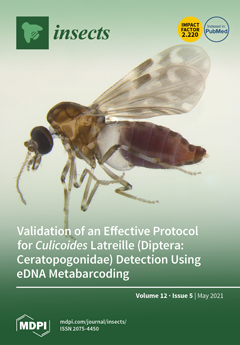The small hive beetle (SHB)
Aethina tumida Murray, (Coleoptera: Nitidulidae) is now a global invasive pest of honey bees, but its cold tolerance potential has not been yet explored. Therefore, we measured the supercooling point (SCP) of different stages of SHBs and also
[...] Read more.
The small hive beetle (SHB)
Aethina tumida Murray, (Coleoptera: Nitidulidae) is now a global invasive pest of honey bees, but its cold tolerance potential has not been yet explored. Therefore, we measured the supercooling point (SCP) of different stages of SHBs and also the impact of acclimation on their SCPs and survival as a measure for cold tolerance. Combinations of different temperatures (0, 3, 5, 7, and 10
C) for different hours (1, 3, 5, 7, 12, 24, 35, and 48 h) were used to assess SHB survival. The supercooling points occurred at lower temperatures (−19.4
C) in wandering larvae than in the other stages (pupae: −12.5
C, and feeding larvae: −10.7
C). A lethal temperature (LT
50) of feeding larvae was achieved earlier at 4.9
C after 7 h exposure than the wandering larvae (3.7
C at 48 h) and pupae (5.6
C at 48 h). The sum of injurious temperature (SIT) is the most suitable estimation to describe cold resistance of the SHB immatures. The wandering larvae were the most cold tolerant, followed by pupae and feeding larvae based on SIT values of −286.8, −153.7 and −28.7 DD, respectively, and also showed more phenotypic plasticity after acclimation than feeding larvae and slightly more than pupae. Our results show that all stages, i.e., feeding larvae, wandering larvae and pupae, are chill susceptible. However, these stages, especially wandering larvae and pupae, showed the capacity to acclimate to cold temperatures, which may help them to survive in winter for the continuity of the SHB population, especially in a scenario of climate change.
Full article






